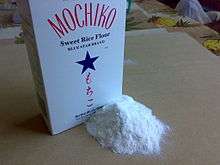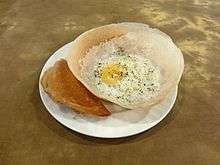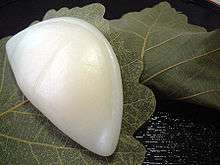Rice flour

Rice flour (also rice powder) is a form of flour made from finely milled rice. It is distinct from rice starch, which is usually produced by steeping rice in lye. Rice flour is a particularly good substitute for wheat flour, which irritates the digestive system of some people. Rice flour is also used as a thickening agent in recipes that are refrigerated or frozen since it inhibits liquid separation.
Production
Rice flour may be made from either white rice or brown rice. To make the flour, the husk of rice or paddy is removed and raw rice is obtained, which is then ground to flour.
Types
Many dishes are made from rice flour, including rice noodles and desserts like Japanese mochi and Filipino cascaron. Vietnamese banh canh uses rice flour and it is also used in making General Tso's chicken.
In China, rice flour, called mǐ fěn (米粉), is used in a variety of dishes, notably different kinds of rice noodles, like mĭxiàn (米线), or fried noodles chǎo mǐ fěn (炒米粉).
In Japanese, rice flour is called komeko (米粉) and is available two forms: glutinous and non-glutinous.[1] The glutinous rice is also called sweet rice, but despite these names it is neither sweet nor does it contain gluten;[2] the word glutinous is used to describe the stickiness of the rice when it is cooked. The glutinous variety called mochigomeko (もち米粉, or mochiko for short) is produced from ground cooked glutinous rice (もち米 mochigome) and is used to create mochi or as a thickener for sauces.[3] Another variety called shiratamako (白玉粉) is produced from ground uncooked glutinous rice and is often used to produce confectioneries.[3] The non-glutinous variety called jōshinko (上新粉) is made from short-grain rice and is primarily used for creating confectioneries.[3]
Rice flour has a presence in South Indian cuisine too. Some of the examples include Dosa, Puttu, Golibaje (Mangalore bajji) and Kori Rotti. It is also mixed with wheat, millet, other cereal flours, and sometimes dried fruits or vegetables to make Manni, a kind of baby food..
It is a regular ingredient in Bangladeshi cuisine, Bengali cuisine and Assamese cuisine. It is used in making roti and desserts such as sandesh and pitha (Rice cakes or pancakes which are sometimes steamed, deep fried or pan fried and served along with grated coconut, sesame seeds, jaggery and chashni). It is also used in making Kheer (a common South Asian dessert).
In Sri Lanka, it's used in making many household food products. It is used in making food products such as Pittu, Appa (hoppers), Indi Appa (String hoppers) and sweets such as Kewum, Kokis, Athirasa and many more. Also it can be used in making bread and other bakery products.
Rice flour is known as galapong in Ilokano/Filipino, and pirinç unu in Turkish.
Uses
Mushroom cultivation
Brown rice flour can be combined with vermiculite for use as a substrate for the cultivation of mushrooms. Hard cakes of colonised substrate can then be fruited in a humid container. This method is often (though not always) employed by growers of edible mushrooms, as it is a very simple and low-cost method of growing mushrooms.

In popular culture
.jpg)
References
- ↑ Hosking, Richard (1997). A Dictionary of Japanese Food. Tuttle Publishing. p. 191. ISBN 9780804820424. Retrieved Jan 29, 2013.
- ↑ Alden, Lori (1996). "Cook's Thesaurus: Rice". Lori Allen. Retrieved 2006-03-02.
- 1 2 3 辻静雄 (2006). Japanese Cooking: A Simple Art. Kodansha International. p. 70. ISBN 9784770030498. Retrieved Jan 29, 2013.
- ↑ 48°52′06″N 2°20′01″E / 48.8683421°N 2.3336035°E
External links
- Japanese rice flours at Wagashi-net.de
